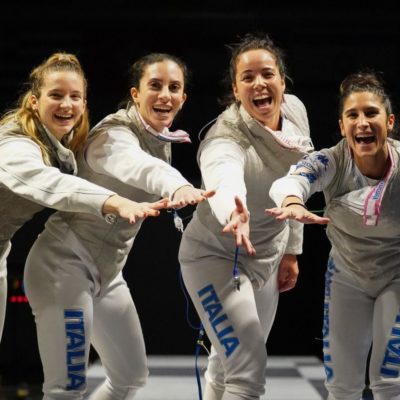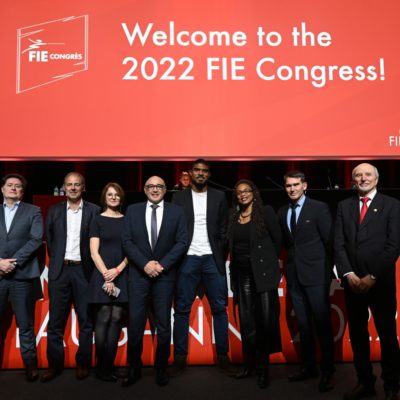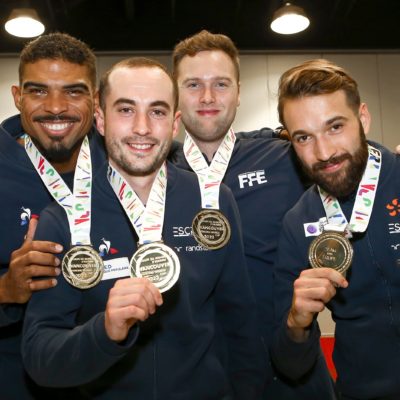{mosimage} Sada Jacobson, Olympic Bronze Medalist, catches up with Serge Timacheff at the Tianjin Grand Prix. Sada is working on getting back up to form after a stress fracture in her shin. Listen as she details just how she’s getting back to form and more on the upcoming tournaments.
Sada tells Serge just why she enjoys the event in Havana, Cuba – even though it’s difficult to get to. Also learn if she’ll be at the US Nationials.
{audio}https://fencing.net/podcast/chn-sada.mp3{/audio}
Transcript
Interviewer: Sada Jacobson, Olympic Bronze Medalist, Multiple Time National Champion, tell us what your ongoing training and results are like right now.
Sada Jacobson: Well, this season has kind of been more of a recovery season for me. I was injured for about the first half of the season and still kind working back to getting back into shape. So that’s been a little bit tough for me, but I’m kind of looking at it as a process and each competition I feel like I’m getting a little bit stronger and back to my old self.
Interviewer: What was the nature of your injury?
Sada Jacobson: I had a _____ fracture in my shin, but it took quite a bit of time to really – I’m still dealing with it a little bit.
Interviewer: How are you dealing with something like that?
Sada Jacobson: Well, it’s kind of getting better by itself, oddly enough. But I’m just gonna try and get through the rest of the season and then rest it as much as I can. It’s difficult because we just started the qualifying season. So you kind of take it as you can and get a couple days in wherever you can find them.
Interviewer: So tell us a little about what your results are like at this point.
Sada Jacobson: Getting better. (Laughter) The first part of the season started out a little bit shaky, but I’m feeling a lot better at this point. I think especially my performances in the team events have been what has satisfied me the most, personally, and so that’s always like a sign to me because it means that the individual is coming up as well.
Interviewer: So what comes next in terms of this season right now?
Sada Jacobson: Well, we have to more World Cups coming up after we get home, Havana and Las Vegas. Las Vegas is the Grand Prix with a team event. Then we have a little time off before we have the Pan American Championships and Worlds in October.
Interviewer: And maybe U.S. Nationals in between?
Sada Jacobson: Absolutely. That too. I completely forgotten about that. (Laughter)
Interviewer: Easy to forget when you’re in China.
Sada Jacobson: Exactly.
Interviewer: Havana is an interesting place. Of course, we were there – we’ve been there many times in the last several years. Obviously, it’s a little bit of a difficult place for Americans to go. Tell us what it’s like to compete in Havana.
Sada Jacobson: It’s definitely one of the most interesting countries, Cuba, as a whole, that I’ve ever been to. It’s just unlike any other place in the world when you see the cars from the 1950s that are driving by, and the condition of the buildings and everything. But at the same time, it’s also one of the most fun countries in spite of the poverty and the difficulties that people go through, they’re just the most positive upbeat people that I’ve met in my travels. So we always really like going there because they always just put on a really good show.
Interviewer: How are the competitions down there? Are they generally pretty well run or are there problems?
Sada Jacobson: Well, it varies from year to year. The last time we were there, which was right before the Olympics, we were in an – it was an open-air venue and that’s a little bit difficult when it’s 80, 85 degrees outside. But in general, I think that they do everything in their power to make sure that the athletes are really showcased and have a good time there.
Interviewer: And you just recently came – speaking of open-air venues, you just recently came from Hanoi and I don’t know that there’s been a Grand Prix in Vietnam other than that one in the last couple of years. It may be a new one. Is that right? If so, tell us a little bit about it.
Sada Jacobson: Well, we were in Hanoi last year and that was also a Grand Prix. So we had a little bit of an idea of what to expect, but it was also very, very hot and not a very air-conditioned venue. When you’re wearing multiple layers of Kevlar, it could be – it’s tough, but it went pretty well all things considered. We made it through.
Interviewer: What were your results there?
Sada Jacobson: We had a silver medal from Becca Ward in the individual. Mariel Zagunis and I both got the bronzes. Then we had a bronze medal result in team.
Interviewer: All right. So tell us a little bit individually for you what you are thinking about going forward in your training and developing and moving towards St. Petersburg in the fall. Tell us what your plans are this summer and what you’re gonna be doing. I understand you’ve had an injury, but tell us a little about not only the physical attributes, but the mental aspects of the sport for you, what you do to kind of keep in top shape.
Sada Jacobson: Well, physically, I think this summer I’m really gonna be focusing on getting into great shape, and that means a lot of cross-training, taking a lot of lessons, doing a lot of swords, things like that. Mentally, I think it’s going to be a question of getting in as much fencing as I can with as many different opponents as I can and being able to simulate competitive experiences and environments, so setting up bouts that are pretty difficult and intense.
Interviewer: Tell us a little bit about – and very many American fencers, for sure, have not had the experience of fencing internationally. Tell us what it’s like a little bit about – what it’s like to fence people from other countries and to encounter people from all kinds of different backgrounds and training as well as cultures.
Sada Jacobson: Well, one of the great things about fencing is that even though we’re fencing a lot of different people who have a lot of different styles, we’ve been doing this for so many years now that you kind of are running into the same people over and over again. My own I’ve been on the international circuit for about the last ten years almost. A lot of the people who – that we’re competing against have also been doing the exact thing. So you really get to know people’s styles. You get to watch them progress as athletes and get better and try out new things.
It’s interesting when you’re fencing because it’s – even though you might be fencing the same people, the fencing is continuously changing, especially with the new timing people are using very different strategies, very different techniques. That makes it a really fun sport because it’s constantly evolving.
Interviewer: Okay. Can you describe a few of those techniques and what they might involve?
Sada Jacobson: Well, with the timing changing, it’s increase the precision and athleticism, I think, of saber. Now, you can no longer afford to have a sloppy attack or to go too slowly or to be out of distance. Everything has to be exactly perfect. I’ve really – that’s one of the things that I really appreciate about the new timing is that it forces you to work on the technical aspects of your game. Because if you don’t have that, it doesn’t matter what your strategy is, you can’t compete.
Interviewer: How is – we’ve heard form other people that video refereeing is good, but that it can disturb the momentum of the bout. How is it for you?
Sada Jacobson: I have some mixed feelings about it. I think that it’s still going through a period of trial and error at this point. People are still getting used to it. They’re still learning how to use it. You have to use it strategically because you only get a certain number of replays that you can request. It definitely can play with the momentum of the bout; play with the flow of the bout. So on the one hand, I think it’s good. I think it makes the sport more objective. On the other hand, I think that there are still some kinks that needs to be worked out.
Interviewer: Would you say that’s also true about wireless technology?
Sada Jacobson: I think that the wireless is a little bit more established. We’ve been doing wireless for about seven years now. I remember we had wireless at Budapest in 2000 at World Championships. I think that they’ve really gotten most everything sorted out in that area. I really like the wireless. I think that it adds something to fencing. Yeah, I think that’s – I can say with greater confidence that the wireless is something that I like.
Interviewer: Who of all the competitors out there do you dread the most when you pull their name on the DE Table?
Sada Jacobson: Who do I dread? I don’t think I’m allowed to say this. No. I think that there are definitely people that I have an easier time with and people who _____ are a little bit more difficult for me. But I wouldn’t say that there was anybody that I really dread getting. For me, if it’s an opponent who I consistently do well with, that I’m happy to have that opportunity, but if it’s somebody who I struggle with, then I look at that as an opportunity to practice against them.
These World Cups, right now, are – I look at it is my training for Beijing if I qualify for that team. So I’m happy when I draw somebody who’s not easy for me because it’s an opportunity for me to get better as a fencer.
Interviewer: Well, that’s very diplomatic. Thanks for your time and good luck with the season.
Sada Jacobson: Thank you.
[End of Audio]





